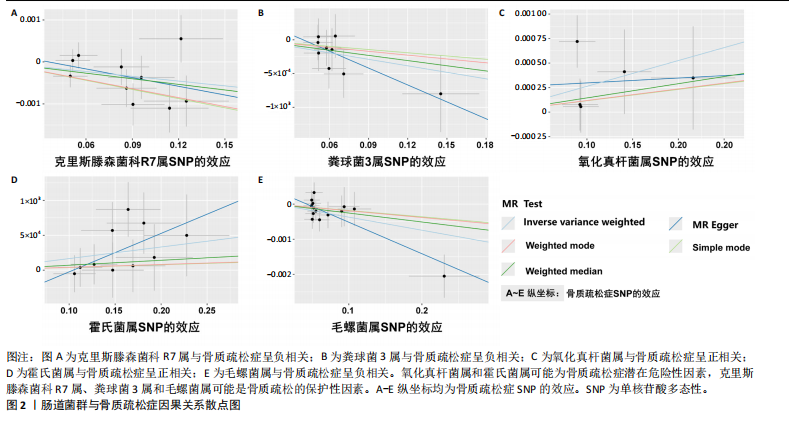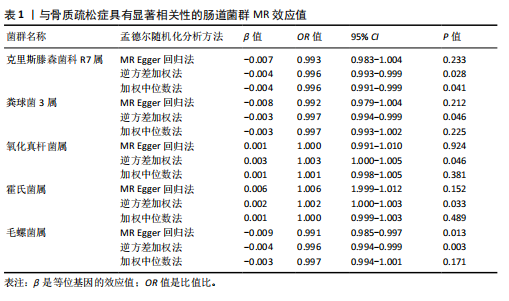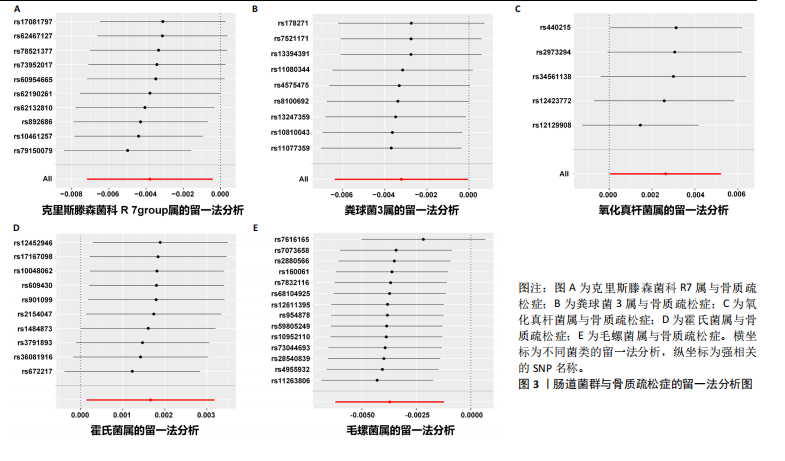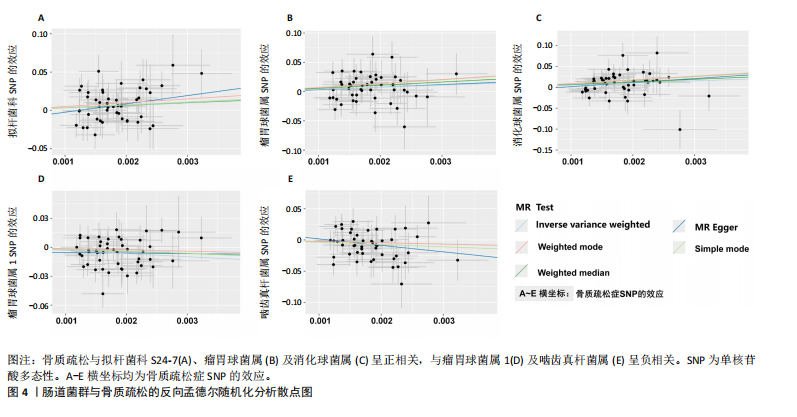[1] ARCEO-MENDOZA RM, CAMACHO PM. Postmenopausal osteoporosis: latest guidelines. Endocrinol Metab Clin North Am. 2021;50(2):167-178.
[2] ZHIVODERNIKOV IV, KIRICHENKO TV, MARKINA YV, et al. Molecular and cellular mechanisms of osteoporosis. Int J Mol Sci. 2023;24(21):15772.
[3] 中华医学会骨质疏松和骨矿盐疾病分会,章振林.原发性骨质疏松症诊疗指南(2022)[J]. 中国全科医学,2023,26(14): 1671-1691.
[4] DING K, HUA F, DING W. Gut microbiome and osteoporosis. Aging Dis. 2020;11(2): 438-447.
[5] LI S, MAO Y, ZHOU F, et al. Gut microbiome and osteoporosis: a review. Bone Joint Res. 2020;9(8):524-530.
[6] CASTANEDA M, STRONG JM, ALABI DA, et al. The Gut microbiome and bone strength. Curr Osteoporos Rep. 2020;18(6): 677-683.
[7] XU Z, XIE Z, SUN J, et al. Gut microbiome reveals specific dysbiosis in primary osteoporosis. Front Cell Infect Microbiol. 2020;10:160.
[8] XU J, ZHANG S, TIAN Y, et al. Genetic causal association between iron status and osteoarthritis: a two-sample mendelian randomization. Nutrients. 2022; 14(18):3683.
[9] FERENCE BA, HOLMES MV, SMITH GD. Using mendelian randomization to improve the design of randomized trials. Cold Spring Harb Perspect Med. 2021;11(7):a040980.
[10] KURILSHIKOV A, MEDINA-GOMEZ C, BACIGALUPE R, et al. Large scale association analyses identify host factors influencing human gut microbiome composition. Nat Genet. 2021;53(2):156-165.
[11] LYON MS, ANDREWS SJ, ELSWORTH B, et al. The variant call format provides efficient and robust storage of GWAS summary statistics. Genome Biol. 2021;22(1):32.
[12] DAVIES NM, HOLMES MV, DAVEY SMITH G. Reading Mendelian randomisation studies: a guide, glossary, and checklist for clinicians. BMJ. 2018;362:k601.
[13] 梁家浩,杨舒龄,王海.基于孟德尔随机化探讨肠道菌群与儿童哮喘的因果关联[J].华西医学,2024,39(4):553-560.
[14] LI P, WANG H, GUO L, et al. Association between gut microbiota and preeclampsia-eclampsia: a two-sample Mendelian randomization study. BMC Med. 2022;20(1): 443.
[15] CAO Y, LU H, XU W, et al. Gut microbiota and Sjögren’s syndrome: a two-sample Mendelian randomization study. Front Immunol. 2023;14:1187906.
[16] PIERCE BL, AHSAN H, VANDERWEELE TJ. Power and instrument strength requirements for Mendelian randomization studies using multiple genetic variants. Int J Epidemiol. 2011;40(3):740-752.
[17] HARTWIG FP,DAVIES NM,HEMANI G, et al. Two-sample Mendelian randomization: avoiding the downsides of a powerful,widely applicable but potentially fallible technique. Int J Epidemiol. 2016;45(6):1717-1726.
[18] YUAN S, CHEN J, RUAN X, et al. Smoking, alcohol consumption, and 24 gastrointestinal diseases: Mendelian randomization analysis. Elife. 2023;12:e84051.
[19] BURGESS S, THOMPSON SG. Interpreting findings from Mendelian randomization using the MR-Egger method. Eur J Epidemiol. 2017;32(5):377-389.
[20] BOWDEN J, DAVEY SMITH G, HAYCOCK PC, et al. Consistent estimation in mendelian randomization with some invalid instruments using a weighted median estimator. Genet Epidemiol. 2016;40(4): 304-314.
[21] 马玮玮,陈虹谷,李彤彤,等.基于孟德尔随机化分析肠道菌群与骨密度的因果关系[J].中国骨质疏松杂志,2023,29(12): 1780-1785.
[22] LARSSON SC, BUTTERWORTH AS, BURGESS S. Mendelian randomization for cardiovascular diseases: principles and applications. Eur Heart J. 2023;44(47): 4913-4924.
[23] YANG M, WAN X, ZHENG H, et al. No evidence of a genetic causal relationship between ankylosing spondylitis and gut microbiota: a two-sample mendelian randomization study. Nutrients. 2023; 15(4):1057.
[24] KANG L, LI P, WANG D, et al. Alterations in intestinal microbiota diversity, composition, and function in patients with sarcopenia.Sci Rep. 2021;11(1):4628.
[25] DAS M, CRONIN O, KEOHANE DM, et al. Gut microbiota alterations associated with reduced bone mineral density in older adults. Rheumatology(Oxford). 2019;58(12):2295-2304.
[26] COSTEA PI, HILDEBRAND F, ARUMUGAM M. Enterotypes in the landscape of gut microbial community composition. Nat Microbiol. 2018;3(1):8-16.
[27] RAFII F. The role of colonic bacteria in the metabolism of the natural isoflavone daidzin to equol. Metabolites. 2015;5(1):56-73.
[28] 何姣姣,陈玉林,张敏,等.肠道菌群在骨质疏松症发病机制中的研究[J].中国骨质疏松杂志,2023,29(8):1197-1202.
[29] SEELY KD, KOTELKO CA, DOUGLAS H, et al. The human Gut microbiota: a key mediator of osteoporosis and osteogenesis. Int J Mol Sci. 2021;22(17):9452.
[30] XU Q, LI D, CHEN J, et al. Crosstalk between the gut microbiota and postmenopausal osteoporosis: mechanisms and applications. Int Immunopharmacol. 2022;110:108998.
[31] HE J, XU S, ZHANG B, et al. Gut microbiota and metabolite alterations associated with reduced bone mineral density or bone metabolic indexes in postmenopausal osteoporosis. Aging. 2020;12(9):8583-8604.
[32] GUAN Z, LUO L, LIU S, et al. The role of depletion of gut microbiota in osteoporosis and osteoarthritis: a narrative review. Front Endocrinol (Lausanne). 2022;13:847401.
[33] WALDBAUM JDH, XHUMARI J, AKINSUYI OS, et al. Association between dysbiosis in the gut microbiota of primary osteoporosis patients and bone loss. Aging Dis. 2023; 14(6):2081-2095.
[34] WANG N, MA S, FU L. Gut microbiota dysbiosis as one cause of osteoporosis by impairing intestinal barrier function. Calcif Tissue Int. 2022;110(2):225-235.
[35] LOCANTORE P, DEL GATTO V, GELLI S, et al. The interplay between immune system and microbiota in osteoporosis. Mediators Inflamm. 2020;2020:3686749.
[36] YAN J, CHARLES JF. Gut microbiome and bone: to build, destroy, or both? Curr Osteoporos Rep. 2017;15(4):376-384.
[37] D’AMELIO P, SASSI F. Gut microbiota, immune system, and bone. Calcif Tissue Int. 2018;102(4):415-425.
[38] GUO M, LIU H, YU Y, et al. Lactobacillus rhamnosus GG ameliorates osteoporosis in ovariectomized rats by regulating the Th17/Treg balance and gut microbiota structure. Gut Microbes. 2023;15(1):2190304.
[39] ZHAO F, GUO Z, KWOK LY, et al. Bifidobacterium lactis Probio-M8 improves bone metabolism in patients with postmenopausal osteoporosis, possibly by modulating the gut microbiota. Eur J Nutr. 2023;62(2):965-976.
[40] JIANG X, QI X, XIE C. Lactobacillus plantarum LP45 inhibits the RANKL/OPG signaling pathway and prevents glucocorticoid-induced osteoporosis. Food Nutr Res. 2023. doi: 10.29219/fnr.v67.9064
|




